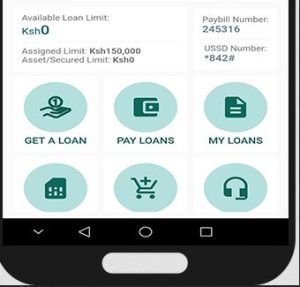When it comes to the sinking fund vs emergency fund, most people choose one over the other, depending on what they need most. The truth is that we need both funds as they aren’t the same.
On the one hand, a sinking fund allows you to save up for a specific future goal or planned expense. And on the other hand, an emergency fund allows you to prepare for unexpected future expenses.
For example, you need a sinking fund to buy a home but an emergency fund to repair the house when its roof collapses. Another scenario is that you need a sinking fund to purchase a new car or a set of new tires, but you need an emergency fund to repair the vehicle when it fails.
Overall, there are so many examples to distinguish between the two funds. But before we can look at their differences, let’s see what the funds have in common.
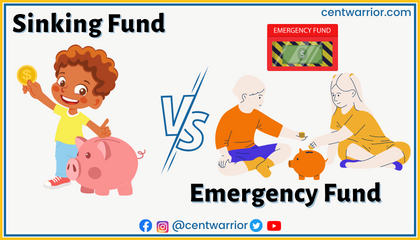
In a rush? The table below clearly differentiates a sinking fund from an emergency fund.
Sinking Fund Vs Emergency Fund Overview
| – | – | Sinking Fund | Emergency Fund |
| 1. | Saving Goal | Save for a planned future expense (specific goal) | Save for an unplanned future expense |
| 2. | Target Amount | It depends on how much the future expenses will cost | 3 – 6 times your household monthly living expense |
| 3. | Number Of Funds You Need | Can be more than one, depending on how many savings goals you have | You only need one |
| 4. | What Happens After Spending | Objective accomplished, but you can start another for a different goal | You must replenish the fund. It has to be always fully funded |
| 5. | When To Set It Up | When planning for a major future expense | Should always be there fully funded, awaiting an unexpected future expense |
| 6. | Liquidity Status | It can be less liquid | It should always be liquid |
| 7. | Room For Fun | There’s room for fun expenses | No room for a fun expense |
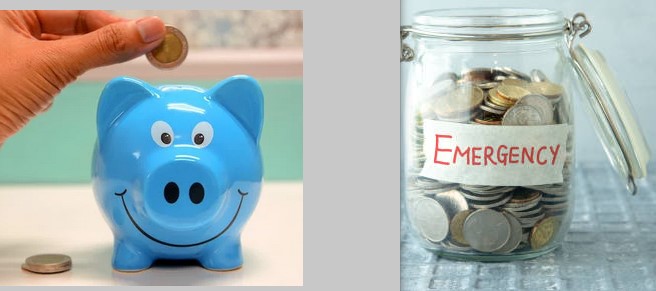
What’s A Sinking Fund?
A sinking fund is money put aside to cater to a specific future expense, mainly a large purchase or bill you cannot settle with a one-month budget. Such expenses include:
- Home Purchase
- Car Purchase
- Wedding expenses
- Baby showers
- Special-event clothes
- Phone upgrade
- Family vacation
- Home appliance purchase
- New furniture
- Honeymoon expenses
- Anniversary expenses
- School fees
Why You Need a Sinking Fund
You need a sinking fund for these reasons:
- Pay for a large expense guilt-free and comfortably – It’s easy to feel guilty after spending money on a large expense you didn’t plan for, as you are likely to constrict your budget. The guilt, however, goes away when you properly save for the expense, and you get to pay for it comfortably.
- Avoid disrupting your other savings goals – A sinking fund stops you from taking money from your other savings account. That includes the emergency fund, retirement account, and others as you specifically save for your target expense.
- Room for fun – Unlike an emergency fund which only caters to emergencies, a sinking fund allows you to save up for a fun experience such as a trip, party, baby shower, or anniversary.
- Unlimited saving potential – There are no limits on what you can save for in a sinking fund. You can do it for any expense, like buying a car, a new home, or a luxurious trip.
- Avoid debt – Let’s face it, it’s easy to get into debt when you pay for a large unplanned expense. But once you plan and save, you can comfortably pay for it without borrowing.
How to Set Up a Sinking Fund
It doesn’t take much to set up a sinking fund. All it takes are these steps:
Step 1 – Determine your savings goal
Decide what you want to save for and how much the expense will cost. Have a rough figure in mind.
Step 2 – Decide on the timeframe
How long do you think it’ll take you to save up the amount? That’ll help you determine how much you can comfortably save each month.
Step 3 – Budget for it
Include your sinking fund in your budget. In that case, that allows you to start saving immediately.
Step 4 – Choose where to save
You can go for a high-yield savings account, a Certificate of Deposits (CDs), a short-term bond, a money market fund account, or any other savings option you prefer.
Our recommendation, however, is a money market fund because of its higher return than a traditional savings account. Besides, money market funds in Kenya are highly liquid and low-risk.
Step 5 – Start saving
Now that everything is set, start saving. Redirect your sinking fund target into your savings account monthly and continue saving until you reach the target.
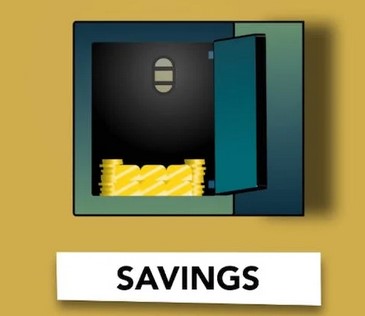
What’s an Emergency Fund?
An emergency fund is money put aside for unplanned future expenses. It’s sometimes known as a Rainy Day fund because it financially prepares you for the rainy day.
Some unplanned future expenses for which you can use an emergency fund include job loss, home renovation, unexpected medical bills, car repairs, unexpected travels, and family emergencies.
Why You Need an Emergency Fund
You generally need an emergency fund for these reasons:
- Protection against unforeseen life events – An emergency fund is your safety net when an unseen life event like a medical bill or job loss hits you.
- Avoid debt – With an emergency fund, you wouldn’t have to borrow to pay for your financial emergencies. You get to avoid the high interests that come with emergency loans.
- Avoid disrupting other savings goals – Just like in a sinking fund, you wouldn’t have to take money out of your other savings account during an emergency. An emergency fund is there to take care of that.
- Easy budgeting – Once you have an emergency fund in place, it becomes easy to budget for everything else since you don’t have to worry about financial emergencies.
- Develop a savings culture – Since you’ve to replenish your emergency fund each time you take money out, saving comes naturally. It develops a savings culture in you, making saving for other expenses easily.
- Mental peace – Nothing leads to mental peace than being free from worrying about how you’ll pay for a financial emergency or having to deal with a loan. That’s what an emergency fund does for you; it gives you mental peace.
- Protect your assets – An emergency fund means you don’t have to sell your assets when facing an unseen financial emergency. You don’t even have to place any of them as security.
How to Set Up an Emergency Fund
Here’s how to build an emergency fund:
Step 1 – Calculate your monthly expense
Determine how much you use at home monthly for essentials like food, rent, electricity, water, and insurance. They must pay expenses.
Step 2 – Decide how much to save
Ideally, you should save 3 – 6 times your monthly living expenses. Overall, the more the amount, the more financial security you enjoy in case of an emergency.
Step 3 – Determine how long to save
You don’t expect to fully find your emergency fund in a month or two unless you sell off something valuable. Depending on your saving tips, it should take 6 – 18 months to fund the emergency fund fully.
Step 4 –Budget for it
You also need to include your emergency fund in your budget to allow you to save for it easily.
Step 5 – Choose where to save
Decide where to put your emergency fund money. The fund should be readily accessible, and you can consider a high-yield savings account, money market fund, online account, or mobile saving account like MSHWARI.
But again, we recommend money market funds for the reasons mentioned earlier.
Step 6 – Start saving
Once everything is ready, go ahead and start saving. You can hasten the saving by setting off something and stashing the money in your emergency fund.
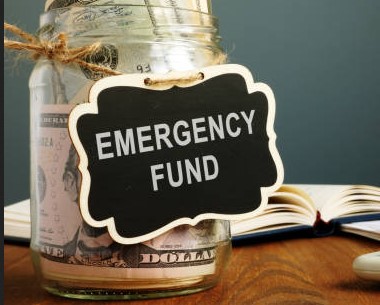
What A Sinking Fund and Emergency Fund Have in Common
Sinking and emergency funds may have different objectives but show some resemblances in a few ways.
First, both involve saving for future expenses. It’s only that the expense is defined in a sinking fund while not in an emergency fund.
The other similarity is that they both involve similar methods of savings. For example, in both cases, you can save in a high-yielding savings account and money market fund.
Moreover, you must include both funds in your budget to make regular monthly contributions.
Difference Between Sinking Fund and Emergency Fund
A sinking fund and an emergency fund differ in the following ways:
1. Saving Goal
A sinking fund lets you save for a defined or specific goal, such as buying a home, upgrading home appliances, getting newer furniture, or going on a family trip.
On the other hand, an emergency fund allows you to save for an undefined, unforeseen life event such as a job loss, medical emergency, or car breakdown.
2. Sinking Funds Vs Emergency Funds Target Amount
With a sinking fund, you can determine beforehand how much to save, depending on what you plan to spend the money on. In contrast, an emergency fund requires saving up to 3 – 6 times your average monthly living expense.
So, the amount depends on your living expense budget, which factors in the rent/mortgage, food, and utility bills, among others.
3. Number of Funds Needed
You can set up as many sink funds as you want, depending on what you want to buy in the future, but you cannot combine them. But when it comes to an emergency fund, you only need to set up one, which you should replenish once you take money out of it.
4. What Happens After Spending
Once you hit your sinking fund target and get to spend the money, you don’t replenish the account. What you can do, however, is start a new sinking fund for a different project.
But when you withdraw from an emergency fund, you must replace it.
5. When to Set It Up
You only set up a sinking fund to pay for a considerable future expense. Once you pay for it, you’ll no longer need that particular sinking fund. You’ll need to start another for a different goal.
In the case of an emergency fund, it should always be there, and you should replenish it once you withdraw from it.
6. Sinking Fund Vs Rainy Day Fund Liquidity Status
A sinking fund can be less liquid since it’s not intended for emergencies. An emergency fund, however, needs to be highly liquid to allow you to access the funds easily in case of a financial crisis.
7. Room for Fun
An emergency fund does not give you any room to have fun since it’s focused on essentials. A sinking fund, in contrast, allows you to save up for any fun activity you may want, such as a vacation or party.
Closing Remarks On the Sinking Fund Vs Emergency Fund
Above are the seven differences that separate an emergency fund from a sinking fund. It’s clear that while both funds involve saving for a future expense, the expense is defined in a sinking fund while it’s not in an emergency fund.
But to balance your life and finances, consider setting up both funds, and that’s where we come in. Our Cent Warrior team is always ready to share about money management and savings. Talk to us on social media, and we will offer you the necessary advisory support.




